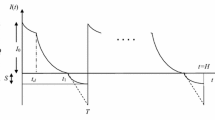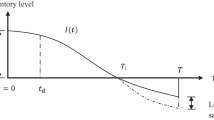Abstract
This paper discusses the production inventory model over an infinite time horizon. Here we consider demand as a function of stock and time. Deterioration is a function of time and time-varying production. Our objective is to minimize the total cost which is a function of set up cost, holding cost, shortage cost, and opportunity cost due to lost sales. The traditional costs such as purchasing cost, shortage cost and opportunity cost due to lost sales are kept constant. We consider holding cost to be a non-linear function of time. Shortages are allowed and are partially backlogged. Here, time durations are the decision variables. Numerical examples are given to illustrate the model.
Similar content being viewed by others
References
Abad P.L.: Optimal pricing and lot sizing under conditions of perishability and partial backordering. Manag. Sci. 42(8), 1093–1104 (1996)
Aggarwal S.P.: A note on an order level inventory model for a system with constant rate of deterioration. Opsearch 15, 184–187 (1978)
Alcali E., Geunes J., Pardalos P.M., Romeijn H.E., Shen Z.J.: Applications of Supply Chain Management and E-commerce Research in Industry. Kluwer Academic Publishers, Dordrecht (2004)
Bose S., Goswami A., Chaudhuri K.S.: An EOQ model for deteriorating items with linear time-dependent demand rate and shortages under inflation and time discounting. J. Oper. Res. Soc. 46(6), 771–782 (1995)
Buzacott J.A.: Economic order quantities with inflation. Oper. Res. Q. 26(3), 553–558 (1975)
Chen J.M., Chen L.T.: Pricing and lot-sizing for a deteriorating item in a periodic review inventory system with shortages. J. Oper. Res. Soc. 55(8), 892–901 (2004)
Chung K.J., Chu P., Lan S.P.: A note on EOQ models for deteriorating items under stock-determent selling rate. Eur. J. Oper. Res. 124(3), 550–559 (2000)
Chung K.J., Ting P.S.: A heuristic for replenishment of deteriorating items with a linear trend in demand. J. Oper. Res. Soc. 44(12), 1235–1241 (1993)
Datta T.K., Pal A.K.: Deterministic inventory systems for deteriorating items with inventory level-dependent demand rate and shortages. Opsearch 27, 213–224 (1990)
Dave U., Patel L.K.: (T, S i ) Policy inventory model for deteriorating items with time proportional demand. J. Oper. Res. Soc. 32(2), 137–142 (1981)
Dye C.Y., Ouyang L.Y.: An EOQ model for perishable items under stock-dependent selling rate and time-dependent partial backlogging. Eur. J. Oper. Res. 163(3), 776–783 (2005)
Geunes J., Pardalos P.M., Romeijn H.E.: Supply Chain Optimization: Applications and Algorithms. Kluwer Academic Publishers, Dordrecht (2002)
Geunes J., Pardalos P.M.: Supply Chain Optimization. Kluwer Academic Publishers, Dordrecht (2003)
Ghare P.N., Schrader G.F.: A model for exponentially decaying inventory. J. Ind. Eng. 15, 238–243 (1963)
Giri B.C., Chaudhuri K.S.: Deterministic models of perishable inventory with stock-dependent demand rate and non linear holding cost. Eur. J. Oper. Res. 105(3), 467–474 (1998)
Goyal S.K., Giri B.C.: Recent trends in modeling of deteriorating inventory. Eur. J. Oper. Res. 134(1), 1–16 (2001)
Goyal S.K., Giri B.C.: The production-inventory problem of a product with time varying demand, production and deterioration rates. Eur. J. Oper. Res. 147(3), 549–557 (2003)
Haiping U., Wang H.: An economic ordering policy model for deteriorating items with time proportional demand. Eur. J. Oper. Res. 46(1), 21–27 (1990)
Hariga M.: Lot sizing models for deteriorating items with time-dependent demand. Int. J. Syst. Sci. 26(12), 2391–2401 (1995)
Hariga M.: Optimal EOQ models for deteriorating items with time-varying demand. J. Oper. Res. Soc. 47(10), 1228–1246 (1996)
Hariga M.: Effects of inflation and time value of money on an inventory model with time-dependent demand rate and shortages. Eur. J. Oper. Res. 81(3), 512–520 (1995)
Manna S.K., Chaudhuri K.S., Chiang C.: Replenishment policy for EOQ models with time-dependent quadratic demand and shortages. Int. J. Oper. Res. 2(3), 321–337 (2007)
Manna S.K., Lee C.C., Chiang C.: EOQ model for non-instantaneous deteriorating items with time-varying demand and partial backlogging. Int. J. Ind. Syst. Eng. 4(3), 241–254 (2009)
Migdalas A., Baourakis G., Pardalos P.M.: Supply Chain and Finance. Springer, New York (2004)
Padmanabhan G., Vrat P.: EOQ models for perishable items under stock-dependent selling rate. Eur. J. Oper. Res. 86(2), 281–292 (1995)
Pardalos P.M., Tsitsiringos V.: Financial Engineering, Supply Chain and E-commerce. Kluwer Academic Publishers, Dordrecht (2002)
Sachan R.S.: On (T, S i ) Policy inventory model for deteriorating items with time proportional demand. J. Oper. Res. Soc. 35(11), 1013–1019 (1984)
Sarkar B.R., Jamal A.M.M., Wang S.: Supply chain model for perishable products under inflation and permissible delay in payment. Comput. Oper. Res. 27(1), 59–75 (2000)
Su C.T., Tong L.I., Liao H.C.: An inventory model under inflation for stock dependent consumption rate and exponential decay. Opsearch 33(2), 71–82 (1996)
Wee H.M.: Economic production lot size model for deteriorating items with partial back-ordering. Comput. Ind. Eng. 24(3), 449–458 (1993)
Wee H.M.: A replenishment policy for items with a price-dependent demand and a varying rate of deterioration. Prod. Plan. Control 8(5), 494–499 (1997)
Wee H.M., Law S.T.: Economic production lot size for deteriorating items taking account of the time value of money. Comput. Oper. Res. 26(6), 545–558 (1999)
Wu K.S., Ouyang L.Y., Yang C.T.: An optimal replenishment policy for non-instantaneous deteriorating items with stock-dependent demand and partial backlogging. Int. J. Prod. Econ. 101(2), 369–384 (2006)
Author information
Authors and Affiliations
Corresponding author
Rights and permissions
About this article
Cite this article
Valliathal, M., Uthayakumar, R. Designing a new computational approach of partial backlogging on the economic production quantity model for deteriorating items with non-linear holding cost under inflationary conditions. Optim Lett 5, 515–530 (2011). https://doi.org/10.1007/s11590-010-0216-8
Received:
Accepted:
Published:
Issue Date:
DOI: https://doi.org/10.1007/s11590-010-0216-8




